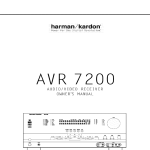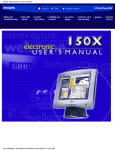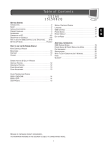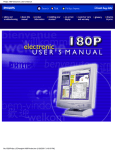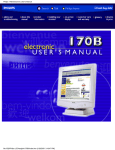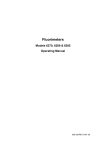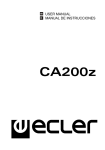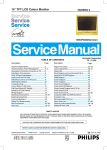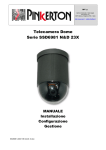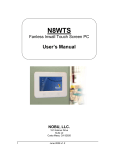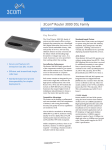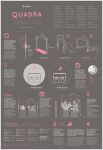Download Philips 18L8025Q Computer Monitor User Manual
Transcript
Table of Contents 181AS 18L8025Q GETTING STARTED INTRODUCTION . . . . . . . . . . . . . . . . . . . . . . . . . . . . . . . . . . 2 SAFETY. . . . . . . . . . . . . . . . . . . . . . . . . . . . . . . . . . . . . . . 2 INSTALLATION LOCATION . . . . . . . . . . . . . . . . . . . . . . . . . . . 3 CORRECT HANDLING . . . . . . . . . . . . . . . . . . . . . . . . . . . . . . 3 ACCESSORIES . . . . . . . . . . . . . . . . . . . . . . . . . . . . . . . . . . 3 CONNECTION TO PC. . . . . . . . . . . . . . . . . . . . . . . . . . . . . 4-6 DESCRIPTION OF CONTROLS . . . . . . . . . . . . . . . . . . . . . . . 7-9 AUDIO FUNCTION CONTROL . . . . . . . . . . . . . . . . . . . . . . . . . 10 HOW TO USE THE OSD [CONTROL LEVEL STRUCTURE] . . . 11-23 SETTING UP GUIDE. . . . . . . . . . . . . . . . . . . . . . . . . . FOLDOUT THIRD WINDOW 5500°K, 6500°K OR 9300°K COLOR TEMPERATURE . . . . . 18 USER PRESETS . . . . . . . . . . . . . . . . . . . . . . . . . . . . . . . . 19 FOURTH WINDOW LANGUAGE . . . . . . . . . . . . . . . . . . . . . . . . . . . . . . . . . . . 20 OSD CONTROLS . . . . . . . . . . . . . . . . . . . . . . . . . . . . . . . 20 VIDEO INPUT PRIORITY . . . . . . . . . . . . . . . . . . . . . . . . . . . 21 POWER SAVING . . . . . . . . . . . . . . . . . . . . . . . . . . . . . . . . 21 ROTARY DEFAULT . . . . . . . . . . . . . . . . . . . . . . . . . . . . . . . 22 EXIT OR RESET . . . . . . . . . . . . . . . . . . . . . . . . . . . . . . . . 23 HOW TO USE THE ON SCREEN DISPLAY (OSD) OSD TIMER . . . . . . . . . . . . . . . . . . . . . . . . . . . . . . . . . . 12 FIRST WINDOW BRIGHTNESS . . . . . . . . . . . . . . . . . . . . . . . . . . . . . . . . . . 13 CONTRAST . . . . . . . . . . . . . . . . . . . . . . . . . . . . . . . . . . . 13 VOLUME . . . . . . . . . . . . . . . . . . . . . . . . . . . . . . . . . . . . . 14 STARTING CLOCK & PHASE ADJUSTMENTS(NON OSD) . . . . . . 14 CLOCK ADJUSTMENT . . . . . . . . . . . . . . . . . . . . . . . . . . . . . 15 PHASE ADJUSTMENT . . . . . . . . . . . . . . . . . . . . . . . . . . . . . 15 ADDITIONAL INFORMATION OSD WARNING SIGNAL . . . . . . . . . . . . . . . . . . . . . . . . 24-25 PIN ASSIGNMENT . . . . . . . . . . . . . . . . . . . . . . . . . . . . . . . 25 BNC CONNECTOR . . . . . . . . . . . . . . . . . . . . . . . . . . . . . . . 25 POWER SAVING & ACCEPTABLE RESOLUTION MODE . . . . . . . . 26 SPECIFICATIONS . . . . . . . . . . . . . . . . . . . . . . . . . . . . . . . . 26 WHAT TO DO IF SOMETHING ISN’T WORKING . . . . . . . . . . . . 27 INDEX. . . . . . . . . . . . . . . . . . . . . . . . . . . . . . . . . . . . . . . 28 GLOSSARY . . . . . . . . . . . . . . . . . . . . . . . . . . . . . . . . . . . 29 WARRANTY . . . . . . . . . . . . . . . . . . . . . . . . . . . INSIDE COVER SECOND WINDOW VERTICAL POSITION . . . . . . . . . . . . . . . . . . . . . . . . . . . . . 16 HORIZONTAL POSITION . . . . . . . . . . . . . . . . . . . . . . . . . . . 16 DISPLAY SIZE . . . . . . . . . . . . . . . . . . . . . . . . . . . . . . . . . 17 EXPAND MODE OPTIMIZATION . . . . . . . . . . . . . . . . . . . . . . . 17 Other language versions FRENCH (FRANCAIS) . . . . . . . . . . . . . . . . . . . . . . . . .29 SPANISH (ESPAÑOL) . . . . . . . . . . . . . . . . . . . . . . . . .57 appendix ENGLISH FRANÇAIS DEUTSCH INFORMATION FOR USERS IN THE U.S.. . . . . . . . . . . . . . . . . . . . . . . . . . . . . A1 FCC DECLARATION . . . . . . . . . . . . . . . . . . . . . . . . . . . . . . . . . . . . . . . . A2 ENERGY DECLARATION. . . . . . . . . . . . . . . . . . . . . . . . . . . . . . . . . . . . . . . A3 TCO’99 . . . . . . . . . . . . . . . . . . . . . . . . . . . . . . . . . . . . . . . . . . . . A4-A5 INFORMATIONS FOR UK ONLY . . . . . . . . . . . . . . . . . . . . . . . . . . . . . . . . . . A6 FCC DECLARATION . . . . . . . . . . . . . . . . . . . . . . . . . . . . . . . . . . . . . . . . A7 GS / ACHTUNG . . . . . . . . . . . . . . . . . . . . . . . . . . . . . . . . . . . . . . . . . . . A8 BECAUSE OF CONTINUOUS PRODUCT IMPROVEMENTS, THE INFORMATION MENTIONED IN THIS DOCUMENT IS SUBJECT TO CHANGE WITHOUT NOTICE. 1 E N Introduction and Safety Introduction E N The Philips Brilliance181AS Flat Panel Monitor satisfies the need of high-end corporate and professional users. This monitor is for those who are seeking advanced design, a small footprint, high quality picture and ergonomic features in a monitor that takes minimal desk space. Its innovative technology delivers outstanding viewing angle and picture quality, zero emissions, and low-energy consumption. Features EXCELLENT DISPLAY QUALITY • 18.1 inch viewable area display - comparable to the viewable screen size of a 19-inch CRT monitor, with even better picture clarity and geometry. • Full compatibility with all standard video cards and all common VESA modes up to 1280 x 1024 resolution with 30 to 82 kHz horizontal scanning. • State of the art image processing for optimal full screen image expansion at resolutions for DOS, VGA 640 x 480, SVGA 800 x 600, XGA 1024 x 768 and SXGA 1280 x 1024. • Two separate video inputs with automatic priority setting and one touch input selction. ERGONOMIC DESIGN • To protect the LCD panel against wear and scratches, an optional protective cover can be ordered separately. Please ask your dealer. • Detachable pedestal for swing arm or wall mount applications. A special hinge design on the monitor ensures full tilt and rotation adjustability even on the simplest mount. • Easy OSD with five (5) language text. • Mouse controlled operation via USB device with CustoMax™ software. • TCO ‘99 approved OTHERS • 1+1W stereo front-firing audio and microphone • USB Bay for connection to the optional powered hub with four (4) downstream ports • Anti-theft Kensington® lock socket and OSD lock to prevent tampering; especially useful at point-of-sale and customer interaction sites. Note: Your monitor operates according to the VESA DDC level 1/2B. Only computers and software that support the same guidelines and operate at the same or a higher level can make use of this feature. If your computer does not support the relevant guidelines, you can still use your monitor and computer. However, you may need to manually specify the appropriate resolution in the software or computer. As an ENERGY STAR® Partner, PHILIPS has determined that this product meets the ENERGY STAR® guidelines for energy efficiency. Contact us at our web site: HTTP://www.pcstuff.philips.com Safety precautions and maintenance • Unplug the monitor, if you are not going to use it for an extensive period of time. • Unplug the monitor, if you need to clean it with a slightly damp cloth. Wiping the screen with a dry cloth is possible when the power is off. However, never use alcohol, solvents, or ammonia-based liquids. • Consult a service technician if the monitor does not operate normally when following the instructions in this manual. • The casing cover should be opened only by qualified service personnel. • Keep the monitor out of direct sunlight and away from stoves or any other heat source. • Remove any object that could fall into the vents or prevent proper cooling of the monitor’s electronics. • Do not block the ventilation holes on the cabinet. • Keep the monitor dry. To avoid electric shock, do not expose it to rain or excessive moisture. • When positioning the monitor, make sure the power plug and outlet are easily accessible. • If turning off the monitor by detaching power cable or DC power cord, wait for 6 seconds, then attach the power cable or DC power cord for normal operation. End-of-life disposal Your new monitor contains materials that can be recycled and reused. Specialized companies can recycle your product to increase the amount of reusable materials and to minimize the amount to be disposed of. Please find out about the local regulations on how to dispose of your old monitor. ENERGY STAR is a U.S. registered mark. IBM and IBM PC are registered trademarks of International Business Machines Corporation. Apple, Macintosh, Quadra, Performa, Power PC and Centris are registered trademarks of Apple Computer, Inc. 2 Installation Locations & Accessories Installation Locations AVOID HEAT AND EXTREME COLD • Take care not to mishandle this product by either knocking or dropping during operation or transportation. • Do not store or use the LCD monitor in locations exposed to high humidity or a dusty environment. Also do not allow water or other liquids to spill on or into the LCD monitor. • Do not store or use the LCD monitor in locations exposed to heat, direct sunlight, or extreme cold. • Avoid moving the LCD monitor between locations with large temperature differences. Choose a site falling within the following temperature and humidity ranges. Temperature: 5-35°C 41-95°F Humidity: 20-80% RH • Do not subject the LCD monitor to severe vibration or high impact conditions. Do not place the LCD monitor inside a car trunk. Correct handling of the monitor 1. When handling the monitor, grip the bottom firmly with both hands and ensure that the front panel faces outward before lifting. Please refer to the diagram on the right. 2.Handling the monitor with care prevents scratching and damage. If the monitor becomes damaged, immediately disconnect the power from the unit and have it checked by a qualified service person before using it again. 3. To prevent fire or electrical shock, do not drop the monitor. 4. When moving the monitor, be sure to unplug all power cords in order to avoid injury or damage to the equipment. Accessories 1. Power cable 2.Signal cable 3. Audio in cable (Blue) 5. Quick Setup Guide 9. Windows disk drive 6. User manual 10. CD-ROM (User manual ) 7. Warranty card Microphone out cable (Red) (connect to sound card) 8. CustoMax User’s manual 4. USB cable Where to buy extra accessories : “ Please contact your local Philips dealer”. 3 VIDEO 1-2 11. CustoMax (for USB control) 12. Macintosh adapter (optional) E N Connection to PC VIDEO SETTINGS E N Before connecting your LCD Monitor to the PC, make sure that the computer’s video settings (resolution and frequency) are in accordance with those below. CD Installation When prompted by the Operating System for the LCD Monitor drivers, insert CD and select the CD-ROM drive as the disk containing the drivers. Windows 98 Windows 98 will auto-detect the new monitor and set-up the correct parameters. If it does not auto-detect the new monitor, use Manual Install. To manually install or update the driver, click on START, SETTINGS, CONTROL PANEL, DISPLAY, SETTINGS tab, ADVANCED, MONITOR tab, CHANGE. This will start the “Update Device Driver Wizard”. Follow the prompts to install the driver. Windows 95 Click on START, SETTINGS, CONTROL PANEL, DISPLAY, SETTINGS tab, ADVANCED PROPERTIES MONITOR tab, CHANGE, HAVE DISK. Install the CD-ROM. 4 Connection to PC Connection to PC Follow the steps below to connect your LCD Monitor to PC. 1 To remove the back cover,use a coin to disengage the clips on each side. 2 Remove the plastic ring from the hinge. 3 Plug in the video cable to the D-sub or BNC (optional)connector. video 5-BNC cable cable (optional) 4 5 7 Blue connector for audio in (speaker) Red connector for microphone out Connect the audio cables to the audio jacks. Microphone out (red connector) a . Connect the power cord to the monitor. . Plug power cord into a grounded power outlet. c . Connect the monitor cable to the computer. Audio in speaker (blue connector) b 5 6 Replace back cover of the monitor. Cover the cables with the plastic ring and put it back on the hinge. Refer to the owner’s manuals included with your earphones and microphone for a detailed guide to setting up these items. 5 E N Connection to PC USB Control (INCLUDED) E N Philips 181AS comes with special software, CustoMax™, to control the monitor from your PC via a USB connection. You may connect the monitor directly or connect to the optional USB hub to the PC down stream port. To install the USB cable for this control function. 181AS LCD monitor is equipped with an optional USB Hub also. 181AS LCD monitor is an USB device also. Refer to the “Setting Up Your Philips Flat Panel Monitor” foldout for a more detailed guide to set up your monitor. USB HUB INSTALLATION (SOLD SEPARATELY) USB (Universal Serial Bus) is an innovation in connecting your IBM-compatible computer to your monitor. By using the optional USB HUB, you will be able to connect optional USB type keyboards, mice, printers, and other peripherals to your monitor instead of having to connect them to your computer. This will give you greater flexibility in setting up your system. Plus, you will have true plug-and-play capability. Philips provides for the optional USB Hub so you will be ready to take advantage of this advancement in computer development. For an IBM-compatible Computer: 1. Turn off the computer. 2. Insert the (optional) USB Hub to the monitor . 3. Connect the USB cable to the monitor’s USB Hub and the computer. (Computer must have USB port.) 4. Connect USB type mouse or USB type keyboard (or both) to the monitor’s USB Hub. 5. Turn on the monitor. Then turn on the computer. 6. With the installation of the correct software, you will be able to connect USB peripherals to the monitor’s USB Hub. Note: 1. If the USB device was halt down, please replug the USB cable , then the HOST will make self-test and enable the device function automatically. 2.USB Hub and cables sold separately. The length of USB cable should be less than 3 meters. The USB Bay is located in the base at the back of the monitor. 3. Please refer to the USB Hub’s manual and installation guide for more details. Refer to the “Setting Up your Philips flat panel monitor” foldout for a more detailed guide to set up your monitor. 6 Description of Controls & Connectors FRONT VIEW Built-in Microphone – Allows you to “speak” into your computer. Brightness Button – Press this button and use the rotary knob to adjust the brightness of the screen. LED – Light Emitting Diode turns green when the monitor is on. Video 1-2 – Allows you to switch between two video inputs (D-SUB, BNC seletion. e.g.Connect D-SUB and 5-BNC video cable to the monitor from different PC at the same time. Then press”Video1-2” button for interchange of Video Display. AUTO Adjust Button – Press this button for optimal picture display. Clock, Phase, Vertical position and Horizontal position are adjusted automatically. Power Button – Turns the monitor On or Off. Speakers – Transmit sounds from your computer or amplifier. Earphone jack Mute Button – Mutes the sound from the speakers and the earphones. Press to turn mute on or off. See next page for details. On Screen Display (OSD) button – Brings up the On Screen Display and helps you navigate through it. REAR VIEW Rotary Knob – Helps guide you through the On Screen Display. When not used with the OSD button, can also adjust the volume. See page 14. USB Bay –Slot for plugging in USB Hub. Optional hardware that allows true Plug-and-Play. See page 6 for installation details. Kensington Lock Socket – A special feature to lock your monitor for anti-theft. Power Plug – Plug the AC power cord in here. See “Setting up” foldout for details. USB connector BNC – R, G, B, H and V input. DC power cord D-Sub connector Audio in connector ( Speaker) 5-BNC cable (optional) USB port Microphone out connector Video cable USB cable 7 E N Description of Controls Using the OSD Button - To use the OSD function, please refer to details starting on page 12. E N Pedestal - With the built-in pedestal, you can tilt and swivel the monitor to the most comfortable viewing angle. For best viewing, always place the monitor at eye level. This pedestal can be separated from the main LCD monitor body for mechanical arm or wall-mount applications (as specified within manufacturer’s recommendations). Using the Auto Button Press this button for optimal NOTE: DO NOT REMOVE WITHOUT FIRST READING “REMOVING INSTRUCTIONS” FOUND IN THE GUIDE BUNDLED WITH THE ACCESSORIES. picture dispaly. Clock,Phase, Vertical position and Horizontal position are adjusted automatically. Using Rotary Knob for AUDIO - Turn rotary knob to adjust audio level. NOTE: THE ROTARY KNOB IS OSD OPERATION WHEN THE OSD BUTTON IS PRESSED. ALSO USED FOR Using the Mute Button - To turn the mute On or Off press the mute button. For Audio model only. 8 Description of Controls On Screen Display - Your monitor is preset at the factory for normal operation. However, you can adjust it by using the On Screen Display Button and the Rotary Knob as described on Page 7. Below is a brief description of the four windows of the On Screen Display function. The first window highlighted after the OSD has been selected. By default, the select block will be on “Brightness”. It has five features: Brightness, Contrast, Volume, Phase Adjustment and Clock Adjustment. Details on adjusting these feutures are on pages 13-15. OSD Button This is the second window highlighted after the OSD has been selected. The four features are: Vertical Position, Horizontal Position, Display Size and Expand Mode Optimization. More details on adjusting these features are on pages 16-17. The fourth window features: Language, OSD Controls, Video Input Priority, Power Saving, and Rotary Default. Details on adjusting these features are on pages 20-23. Note: Language allows you to change the On Screen Display from English to French, Spanish, German, or Italian. See Page 20 for more details. The third window highlighted is the adjustment of the Color Temperature. Select the color temperature you prefer or make your own with User Setting 1 or 2. Details are on pages 18-19 9 E N AUDIO FUNCTION CONTROL Microphone cable (red) connection E N REAR VIEW (monitor) FRONT VIEW (monitor) Plug the red Microphone connector into the Microphone out port of your monitor. Microphone (Voice in) Note: To use the supplied audio cable or an equivalent cable of less than 3m. Monitor PC Microphone out cable(red) To Monitor To PC Plug the other end of Microphone connector into the sound input port of your computer. Audio cable(bLue) connection Front view of monitor Rear view of monitor Plug the other end of Audio connector into the Audio in port of your monitor. Plug the blue Audio connector into the sound output port of your computer. Note: To use the supplied audio cable or an equivalent cable of less than 3m. Speaker(sound output) Audio in cable(blue) or to Earphone jack To PC To Monitor 10 How to Use the On Screen Display (OSD) OSD Menu control level structure E N 11 How to Use the On Screen Display (OSD) OSD TIMER OSD Controls E N OSD SWITCHES OFF AUTOMATICALLY AFTER 5 SECONDS (DEFAULT IS 5 SECONDS). WITH OSD CONTROLS, you can set the amount of time it takes for the On Screen Display to time out or change the vertical and horizontal position of the OSD on the monitor screen. 8 Press the OSD button. Press the OSD button. 1 VIDEO 1-2 OSD button 2 Turn the ROTARY knob until the OSD CONTROLS icon is highlighted. VIDEO 1-2 Rotary Knob OSD control icon 3 7 Turn the Rotary Knob to select Yes to save changes or No to discard changes. Then, press the OSD button to confirm your choice and exit the OSD. Press the OSD button to bring up OSD CONTROLS screen. 4 Press the OSD button to bring up TIMER screen. 5 6 Turn the ROTARY knob to select : 05, 10, 25 seconds, or OFF. Press the OSD button to confirm the selection and return to EXIT window. 12 How to Use the On Screen Display (OSD) First window Contrast Brightness To adjust your screen’s brightness, follow the steps below. Brightness is the overall intensity of the light coming from the screen. To adjust your screen’s contrast, follow the steps below. Contrast is the difference between the brightest and darkest areas on the screen. 1 Press the OSD button. 1 Press the OSD button. 2 2 By default, the BRIGHTNESS icon is highlighted. 3 Press the OSD button to bring up BRIGHTNESS screen. 3 Turn the Rotary Knob clockwise until the CONTRAST icon is highlighted. Press the OSD button to bring up CONTRAST screen. 4 4 5 5 Press the OSD button to return to EXIT window. Press the OSD button to return to EXIT window. Turn the Rotary Knob to adjust the brightness. Smart Help Turn the Rotary Knob to adjust the contrast. Smart Help After returning to Exit . . . . . .to continue to Contrast, turn the Rotary Knob clockwise until the CONTRAST icon is highlighted. Next, follow steps 3 - 5 under CONTRAST. . . . to exit completely, press the OSD button and choose either SAVE or Don’t SAVE in setting mode, then push OSD button to exit OSD. (See page 23 for other exit options.) After returning to Exit . . . . . . to continue to Volume, turn the Rotary Knob clockwise until the VOLUME icon is highlighted. Next, follow steps 3 - 5 under VOLUME (on the next page). . . . to exit completely, press the OSD button and choose either SAVE or Don’t SAVE in setting mode, then push OSD button to exit OSD. (See page 23 for other exit options.) 13 E N How to Use the On Screen Display (OSD) First window STARTING CLOCK& PHASE Adjustments Volume E N To adjust your monitor’s audio volume, follow the steps below. The volume control adjusts the sound from the two front-cabinet speakers or the earphone jack. 1 Due to different video signal input from the video card of PC, it is necessary to adjust the CLOCK and PHASE phenomenon for the optimal video display of LCD monitor. To start CLOCK and PHASE Adjustment, simply follow these steps: Press the OSD button. Step 1 : Click on the Start button (Win95, Win98 or Win NT and move your mouse pointer to highlight the word”Shut Down...”. as shown in Fig.1.A. 2 Turn the ROTARY knob clockwise until the VOLUME icon is highlighted. Fig.1.A 3 Step 2 : The menu of “ Shut Down Windows “ is as shown in Fig.1.B Press the OSD button to bring up VOLUME screen. 4 Fig.1.B 5 Press the OSDbutton to return to EXIT window. Turn the ROTARY knob to adjust the volume. Step 3 : With the Shut Down Window still up on the screen, follow the CLOCK and PHASE Adjustment instructions on page 15 for the optimal video display. Smart Help After returning to Exit . . . . . . to continue to Clock Adjustment, turn the ROTARY knob clockwise until the CLOCK ADJUSTMENT icon is highlighted. Next, follow steps 3-5 under CLOCK ADJUSTMENT. . . . to exit completely, press the OSD button and choose either SAVE or Don’t SAVE in setting mode, then push OSD button to exit OSD. (See page 23 for other exit options.) 14 How to Use the On Screen Display (OSD) First window Clock Adjustment Phase Adjustment Clock Adjustment reduces the vertical flicker of the image on the screen to a minimum. 1 Phase Adjustment reduces the horizontal flicker of the image on the screen to a minimum. Press the OSD button. 1 2 Turn the ROTARY knob clockwise until the CLOCK ADJUSTMENT icon is highlighted. 2 Turn the ROTARY knob clockwise until the PHASE ADJUSTMENT icon is highlighted. 3 Press the OSD button to bring up the CLOCK ADJUSTMENT screen. 3 Press the OSD button to bring up PHASE ADJUSTMENT screen. 4 4 5 Press the OSD button to return to EXIT window. Press the OSD button. 5 Turn the ROTARY knob until the image on the monitor does not flicker. (Vertical flicker) Press the OSD button to return to EXIT window. Smart Help Turn the ROTARY knob to adjust the Phase Adjustment. Smart Help After returning to Exit . . . . . . to continue to the Phase Adjustment, turn the ROTARY knob clockwise until the PHASE ADJUSTMENT icon is highlighted. Next, press the OSD button. Follow steps 3-5 under PHASE ADJUSTMENT . . . to exit completely, press the OSD button and choose either SAVE or Don’t SAVE in setting mode, then push OSD button to exit OSD. (See page 23 for other exit options.) After returning to Exit . . . . . . to continue to the Vertical Position, turn the ROTARY knob until the VERTICAL POSITION icon in the second window is highlighted. Next, follow steps 3-5 under VERTICAL POSITION(on the next page). . . . to exit completely, press the OSD button and choose either SAVE or Don’t SAVE in setting mode, then push OSD button to exit OSD. (See page 23 for other exit options.) 15 E N How to Use the On Screen Display (OSD) Second window Horizontal Position Vertical Position E N Horizontal Position shifts the image on your screen either to the left or right. Use this feature if the image does not appear centered. Vertical Position adjusts the image on your screen either up or down. Use this feature if the image does not appear centered. 1 Press the OSD button. 1 Turn the ROTARY knob until the HORIZONTAL POSITION icon is highlighted. 2 Turn the ROTARY knob until the VERTICAL POSITION icon is highlighted. 2 Press the OSD button. 3 Press the OSD button to bring up the VERTICAL POSITION screen. 3 Press the OSD button to bring up the HORIZONTAL POSITION screen. 4 4 5 Press the 5 Press the OSD button to return to EXIT window. OSD button to return to EXIT window. Turn the ROTARY knob until the image is vertically balanced. Turn the ROTARY knob until the image is horizontally balanced. Smart Help Smart Help After returning to Exit . . . . . . to continue to Display Size, turn the ROTARY knob until DISPLAY SIZE is highlighted. Next, follow steps 3-5 under DISPLAY SIZE. . . . to exit completely, press the OSD button and choose either SAVE or Don’t SAVE in setting mode, then push OSD button to exit OSD. (See page 23 for other exit options.) After returning to Exit . . . . . . to continue to the Horizontal Position, turn the ROTARY knob until the HORIZONTAL POSITION icon is highlighted. Next, follow steps 3-5 under HORIZONTAL POSITION. . . . to exit completely, press the OSD button and choose either SAVE or Don’t SAVE in setting mode, then push OSD button to exit OSD. (See page 23 for other exit options.) 16 How to Use the On Screen Display (OSD) Second window Expand Mode Optimization Display Size Expand Mode Optimization is available when the input video mode nuder 1280 x 1024. It helps you to select the best display quality for text - or graphic - oriented applications. Display Size allows you to adjust picture size when the input video mode is under 1280 x 1024. It has 3 options, full screen, real mode, and user’s setting. 1 1 Press the OSD button. Press the OSD button. Turn the ROTARY knob until the EXPAND MODE icon is highlighted. 2 2 Turn the ROTARY knob until the DISPLAY SIZE icon is highlighted. 3 Press the OSD 3 Press the OSD button to bring up the DISPLAY SIZE screen. 5 button to bring up the EXPAND MODE screen. Press the OSD button to return to EXIT window. 4 4 5 Turn the ROTARY knob to select FULL SCREEN, REAL MODE, OR USER SETTING. Press the OSD button to return to EXIT window. Turn the ROTARY knob to adjust the monitor to be TEXT or GRAPHIC mode. Smart Help Smart Help After returning to Exit . . . . . . to continue to Color Temperature, turn the ROTARY knob until one of the COLOR TEMPERATURE icons is highlighted. Next, follow steps 3-5 under COLOR TEMPERATURE. . . . to exit completely, press the OSD button and choose either SAVE or Don’t SAVE in setting mode, then push OSD button to exit OSD. (See page 23 for other exit options.) After returning to Exit . . . . . . to continue to the Expand Mode Optimization, turn the ROTARY knob until the EXPAND MODE OPTIMIZATION icon is highlighted. Next, follow steps 3-5 under EXPAND MODE. . . . to exit completely, press the OSD button and choose either SAVE or Don’t SAVE in setting mode, then push OSD button to exit OSD. (See page 23 for other exit options.) 17 E N How to Use the On Screen Display (OSD) Third window 5500° K, 6500° K or 9300° K Color Temperature(Video display change) E N Your monitor has three preset options for color temperatures from which you can choose : 6500° K option for Desktop Publishing (DTP), 9300° K option for Computer Aided Design (CAD) work, or 5500° K option for photo retouch. When you select an option, the monitor automatically adjusts itself for that color temperature. the default setting for color temperatures is 6500° K. Press the OSD button. 1 2 Turn the ROTARY knob until one of the COLOR TEMPERATURE icons is highlighted. 6 3 Press the OSD button to bring up SAVE screen. Turn the Rotary Knob to select Yes to save changes or No to discard changes. Then, press the OSD button to confirm your choice and Exit the OSD. Turn the ROTARY knob until 9300°K, 6500°K or 5500°K is highlighted. 5500°K : Dark color 6500°K : Dim color 9300°K : Bright color 5 4 Press the OSD button to return to the EXIT window. Press the OSD button to confirm the selection. Smart Help After returning to Exit . . . . . . to continue to User Presets, turn the ROTARY knob until one of the USER PRESET icons is highlighted. Next, follow steps 3- 8 under USER PRESETS on the next page. . . . to exit completely, press the OSD button and choose either SAVE or Don’t SAVE in setting mode, then push OSD button to exit OSD. (See page 23 for other exit options.) 18 How to Use the On Screen Display (OSD) Third window User Presets Fllow the steps below to set a custom color temperature. You can make individual adjustments for each color. 1 Press the OSD button. 2 Turn the ROTARY knob until one of the USER PRESET icons is highlighted. : Adjustment of the colors red,green and blue. : Adjustment of the colors red,green and blue. 9 Press the OSD button to bring up SAVE screen. Turn the Rotary Knob to select Yes to save changes or No to discard changes. Then, press the OSD button to confirm your choice and Exit the OSD. 8 You will now be back at the EXIT window. See SMART HELP below for options. 7 To exit USER PRESET 1 , press the OSD button. Next, press the OSD button again to return to EXIT window. 5 6 When done with green, press the OSD button. BLUE will be highlighted. Then, turn the ROTARY knob to increase or decrease the blue. 4 3 If necessary, turn the ROTARY knob until of the USER PRESETS is highlighted. Next, press the OSD button to confirm the selection. First, RED will be highlighted. When done with red, press the OSD button. GREEN will be highlighted. Then, turn the ROTARY knob to increase or decrease the green. Next, to adjust the red, press the OSD button again. Then, turn the ROTARY knob to increase or decrease the red. Smart Help After returning to Exit . . . . . . to continue to User Preset 2, repeat steps 3 through 7, selecting USER PRESET 2. . . . to continue to Language, turn the ROTARY knob until LANGUAGE ICON is highlighted. Next, press the ON SCREEN DISPLAY button. Now, follow steps e - 5 under LANGUAGE on the next page. . . .to exit the On Screen Display completely, press the OSD button and choose either SAVE or Don’t SAVE in setting mode, then push OSD button to exit OSD. (See page 23 for other exit options.) 19 E N How to Use the On Screen Display (OSD) Fourth window Language E N OSD Controls WITH OSD CONTROLS, you can set the amount of time it takes for the On Screen Display to time out or change the vertical and horizontal position of the OSD on the monitor screen. Besides, you can also view P RODUCT I NFORMATION , including the serial number and hours of operation for your reference. The ON SCREEN DISPLAY shows its settings in one of five languages. The default is English, but you can also select French, Spanish, German, or Italian. 1 Press the OSD button. 1 Press the OSD button. 2 2 Turn the ROTARY knob until the LANGUAGE icon is highlighted. 7 3 Press the ON SCREEN DISPLAY button to bring up LANGUAGE screen. To continue to select VERTICAL or HORIZONTAL POSITION of the OSD, or to see the PRODUCT INFORMATION, repeat same steps Turn the ROTARY knob until the OSD CONTROLS icon is highlighted. 3 Press the OSD button to bring up OSD CONTROLS screen. 4 Press the OSD button to bring up TIMER screen. 4 5 Press the OSD button to return to EXIT window. Then, see SMART HELP below for option. Turn the ROTARY knob until the desired language is selected. 6 Smart Help 5 Turn the ROTARY knob to select : 05, 10, 25 seconds, or OFF. Press the OSD button to confirm the selection and return to EXIT window. Smart Help After returning to EXIT . . . . . . to continue to VIDEO INPUT PRIORITY, turn the ROTARY knob until the VIDEO INPUT PRIORITY icon is highlighted. Next, follow steps 3-5 under VIDEO INPUT PRIORITY (on the next page). . . . to exit completely, press the OSD button and choose either SAVE or Don’t SAVE in setting mode, then push OSD button to exit OSD. (See page 23 for other exit options.) After returning to EXIT . . . . . . to continue to OSD CONTROLS, turn the ROTARY knob until the OSD CONTROLS icon is highlighted. Next,follow steps 3-5 under OSD CONTROLS. . . . to exit completely, press the OSD button and choose either SAVE or Don’t SAVE in setting mode, then push OSD button to exit OSD. (See page 23 for other exit options.) 20 How to Use the On Screen Display (OSD) Fourth window Video Input Priority Power Saving POWER SAVING helps save energy when the monitor is on but not being used. After a preset time, the screen will go blank. To select POWER SAVING, follow the steps below. THE VIDEO INPUT PRIORITY setting defines which video source is displayed by default on the screen when two video sources are available to the monitor. 1 Press the OSD button. 1 Press the OSD button. 2 Turn the ROTARY 2 Turn the ROTARY knob until the VIDEO INPUT PRIORITY icon is highlighted. 3 5 knob until the POWER SAVING icon is highlighted. 3 Press the OSD button to bring up VIDEO INPUT PRIORITY screen. Press the OSD button to return to EXIT window. Press the OSD button to bring up POWER SAVING screen. 5 Press the OSD button to return to EXIT window. 4 Turn the ROTARY 4 Turn the ROTARY knob to select POWER SAVING ON or OFF. knob to select BNC OR VGA D-SUB. Smart Help Smart Help After returning to EXIT . . . . . . to continue to Rotary Default, turn the ROTARY knob until the ROTARY DEFAULT icon is highlighted. Next, follow the steps 3-5 under ROTARY DEFAULT (on the next page). . . . to exit completely, press the OSD button and choose either SAVE or Don’t SAVE in setting mode, then push OSD button to exit OSD. (See page 23 for other exit options.) After returning to EXIT . . . . . . to continue to POWER SAVING, turn the ROTARY knob until POWER SAVING is highlighted. Next, follow steps 3-5 under POWER SAVING. . . . to exit completely, press the OSD button and choose either SAVE or Don’t SAVE in setting mode, then push OSD button to exit OSD. (See page 23 for other exit options.) 21 E N How to Use the On Screen Display (OSD) Fourth window Rotary Default E N R OTARY D EFAULT allows you to pick which feature the ROTARY knob defaults to when used without first pressing the OSD button. The normal default is Volume. To select your Rotary Default, follow the steps below. 1 Press the OSD button. 2 Turn the ROTARY knob until the ROTARY DEFAULT icon is highlighted. 3 Press the OSD button to bring up ROTARY DEFAULT screen. 5 Press the OSD button to return to EXIT window. 4 Turn the ROTARY knob to select BRIGHTNESS, CONTRAST, or VOLUME. Smart Help After returning to EXIT . . . . . . to continue to another window, turn the ROTARY knob until that window is highlighted. Next, follow the instructions for that window. . . . to exit completely, press the OSD button and choose either SAVE or Don’t SAVE in setting mode, then push OSD button to exit OSD. (See page 23 for other exit options.) 22 How to Use the On Screen Display (OSD) Exit or Reset Reset EXIT Choosing RESET returns all the settings for the current video mode to factory presets. Choosing EXIT allows you to exit the OSD screen and save or discard changes you mode to the monitor settings. 1 When you are at the first level control window. For example the BRIGHTNESS icon is highlighted. 1 When you are at the first level control window. For example the BRIGHTNESS icon is highlighted. 2 Turn the ROTARY knob until EXIT is highlighted. Next, press the OSD button. 2 Turn the ROTARY knob until RESET is highlighted. Next, press the OSD button. 3 Turn the Rotary knob to 3 Turn the Rotary Knob to select RESET ALL SETTINGS, YES or NO. Press the OSD button to EXIT. select YES to save changes or No to discard changes. Then, press the OSD button to confirm your choice and exit the OSD. 23 E N Additional Information OSD Warning Signal E N Warning signals display information and alerts about the status of the monitor. • NO VIDEO INPUT • This screen is displayed when there is no video signal input. Please check that the signal cable is properly connected to the Video card or PC. • CANNOT DISPLAY THIS VIDEO MODE • This screen warns when the input from the computer is not a standard video mode or out of the monitor’s scanning range. Please change the display mode of the operating software in the computer (i.e. Windows) to 1280 x 1024 @ 60 Hz for best display results. • ENTERING SLEEP MODE • This screen appears when the monitor is about to enter the sleep mode. Please press any key on the keyboard or click the mouse to wake up the monitor and computer. • USE 1280 X 1024 FOR BEST RESULT • This message appears at the bottom of the OSD window when the video mode input is not the recommended 1280 x 1024. Other modes may result in some picture distortion. Please adjust the video mode to 1280 x 1024 @ 60 Hz for best display quality. 24 Additional Information OSD Warning Signal • THIS IS THE BEST PICTURE SHAPE • This screen appears when the picture size is extended to the edge of viewable area with the same video aspect ratio. The picture size can be futher enlarged to full screen size with a distorted aspect ratio if you continuously turn the size control.This applies when the user attempts to stretch 4:3 aspect resolutions (640x480, 800x600,1024x768 or others) to totally fill the screen. • WAIT FOR AUTOMATIC ADJUSTMENT • This screen appears when you touch the AUTO button. It will disappear when the monitor is properly adjusted. • SECOND VIDEO IS NOT AVAILABLE • This screen appears when there is no second video source input. Pressing the VIDEO 1-2 BUTTONS on the front of LCD monitor can switch the video input signal between the D-sub and BNC connectors. This message appears if one of the signals is not available. BNC Connector Pin Assignment The 5 BNC connectors are positioned as follows: The 15-pin D-sub connector (male) of the signal cable: Pin No. 1 2 3 4 5 6 7 8 9 10 11 12 13 14 15 Assignment Red video input Green video input Blue video input Identical output - connected to pin 10 Self test Red video ground Green video ground Blue video ground No pin Logic ground Identical output - connected to pin 10 Serial data line (SDA) H. Sync / H+V V. Sync (VCLK for DDC) Data clock line (SCL) 25 Pin R: Assignment Red video input G: Green video input B: Blue video input H: Horizontal sync V: Vertical sync BNC R G B H V E N Additional information Acceptable Resolution Modes Automatic Power Saving E N If you have a VESA DPMS compliant display card or software installed in your PC, the monitor can automatically reduce its power consumption when not in use. If input from a keyboard, mouse, or other device is detected, the PC & monitor automatically “wake up.” The table below shows the power consumption and signalling of the automatic power-saving feature. VESA mode Video Power Management Definition H-sync V-sync Power Power used saving(%) Yes Yes < 60W 0% No Yes < 5 W 88.8% Yes No < 5 W 88.8% No No < 5W 88.8% LED color Green Amber Amber Amber The table below shows the 27 video modes that can be displayed with this monitor. MODE RESOLUTION H. FREQ. (KHZ) V. FREQ. (HZ) 1* 640 x 350 31.5 70 IBM VGA 10h 2* 720 x 400 31.5 70 IBM VGA 3h 3* 640 x 480 37.5 75 VESA 4 640 x 480 37.9 72 VESA • This monitor is ENERGY STAR® compliant . 5 640 x 480 35.0 67 VESA 6* 640 x 480 31.5 60 VESA As an ENERGY STAR® Partner, PHILIPS has determined that this product meets the ENERGY STAR® guidelines for energy efficiency. 7* 800 x 600 35.2 56 VESA 8* 800 x 600 46.9 75 VESA The proper operation of the function requires a computer with VESA DPMS power management capabilities. 9* ON Stand-by Suspend OFF Active Blanked Blanked Blanked • Above power consumptions exclude USB watts. Specifications DISPLAY Type VIEWABLE IMAGE SIZE (VIS) SURFACE TREATMENT WEIGHT (UNPACKED) MAXIMUM DIMENSIONS Height Depth Width MAXIMUM GRAPHICS RESOLUTION TEXT MODE DOT PITCH HORIZONTAL FREQUENCY VERTICAL FREQUENCY ENVIRONMENTAL REQUIREMENTS TEMPERATURE Operating Temperature Storage Temperature HUMIDITY (NON-CONDENSING) Operating Non-operating POWER SOURCE POWER CONSUMPTION INPUT TERMINAL Power Cable Pedestal Tilt Swivel : : : : : 18.1-inch (46 cm) Flat panel active matrix-TFT LCD 18.1-inch diagonal (46 cm) Anti-glare coating 8.5kgs : 476 mm : 181 mm : 451 mm : : : : : 1280 x 1024 at 75 Hz Refresh Rate 720 x 400 0.28 mm 30 to 82 kHz 56 to 76 Hz : 41 to 95°F : -13 to 140°F 5 to 35°C -25 to 60°C : Max. 80% : Max. 95% : 100-240VAC±10%,50-60Hz(90264VAC) : < 48 watt (typical value, excluding USB) : 15-pin D-type connector with cable or 5 BNC connector : Non-shield : 0° - 30° : ±40° 26 STANDARD 800 x 600 37.9 60 VESA 10* 832 x 624 49.7 75 MAC 11 48.1 72 VESA 12* 1024 x 768 60.0 75 VESA 13* 1024 x 768 48.4 60 VESA 14 1024 x 768 56.5 70 VESA 15 1024 x 768 61.1 76 IBM XGA-2 16 1152 x 864 67.5 75 VESA 17 800 x 600 1152 x 864 63.9 70 non-VESA 18* 1152 x 870 68.7 75 MAC 19 1152 x 900 61.8 66 SUN Mode IV 20* 1152 x 900 71.8 76 SUN Mode II 21 1280 x 960 60.0 60 VESA 22 1280 x 960 75.0 75 non-VESA 23 1280 x 1024 76.0 72 DOS/V 24* 1280 x 1024 64.0 60 VESA 25* 1280 x 1024 80.0 75 VESA 26* 1280 x 1024 81.1 76 SUN Mode I 27 71.7 67 SUN Mode V 1280 x 1024 * Factory preset mode. Additional Information What to Do if Something isn't Working Troubleshooting This page presents problems that can be corrected by the user. If the problem still exists after these possible solutions, contact your nearest Philips dealer. No Picture (Power LED not lit) • Make sure the Power cable is plugged to the wall and back of the monitor. • Make sure the DC power cord has been attached to the DC Jack. • First, power button in front of the monitor should be in the OFF position, then press it to ON position again. No Picture (Power LED is Amber or Yellow in color) • Make sure the computer is turned on. • Make sure the signal cable is properly connected to your computer. • Check to see if the monitor cable has bent pins. • The Energy Saving Feature may be activated. See pages 2 and 26 for more detail. Screen says • Make sure the monitor cable is properly connected to your computer. See Setting Up foldout. • Check to see if the monitor cable has bent pins. • Make sure the computer is turned on. AUTO button not working properly • The AUTO FUNCTION is designed for use on standard Macintosh or IBM-compatible PC running Microsoft Windows. • It may not work properly if using non-standard PCs or video card. Imaging Problems Display position is incorrect • Push the AUTO button. • Adjust the image position using the HORIZONTAL POSITION &/or VERTICAL POSITION in the SECOND WINDOW. See page 16. Image vibrates on the screen • Check that the signal cable is properly connected to the graphics board or PC. Vertical flicker appears • Push the AUTO button. • Eliminate the vertical bars using the CLOCK ADJUSTMENT in the FIRST WINDOW. See Page 14 & 15 for details. Horizontal flicker appears • Push the AUTO button. • Eliminate the horizontal bars using the PHASE ADJUSTMENT in the FIRST WINDOW. See Page 14 & 15 for details. The screen is too bright or too dark • Adjust the contrast and brightness using the FIRST WINDOW. See Page 13 for details. (The backlight of the LCD monitor has a fixed life span. When the screen becomes dark or begins to flicker, please contact your dealer.) An after-image appears • If an image remains in the screen for an extended period of time, it may be imprinted in the screen and leave an after-image. This usually disappears after a few hours. An after-image remains after the power has been turned off • This is characteristic of liquid crystal and is not caused by a malfunction or deterioration of the liquid crystal. The after-image will disappear after a set amount of time. Green, red, blue, dark, and white dots remains on the screen • The remaining dots are normal charactericstic of the liquid crystal used in today’s technology. 27 E N Additional Information Glossary Index EE N Accessories . . . . . . . . . . . . . .3 Audio-in Cable . . . . . . . .3,5,10 Audio Controls . . . . .5, 7-8,10 Automatic Power Saving . . .26 BNC Connector . . . . . . . . . .25 Brightness . . . . . . . . . . .7,9,13 Built-in microphone . . . . . . .7 Clock Adjustment . . . . . . . .15 Color Temperature . . . . . . .18 Contrast . . . . . . . . . . . . . . . .13 Correct handling . . . . . . . . .3,5 Description of controls . . .7-9 Display Size . . . . . . . . . . . . .17 End-of -life disposal . . . . . . .2 Exit . . . . . . . . . . . . . . . . . . .23 Expand Mode Optimization .17 Features . . . . . . . . . . . . . . . . .2 Glossary . . . . . . . . . . . . . . .28 Horizontal Position . . . . . . .16 Kensington Lock . . . . . . . . . .7 Installation location . . . . . . . .3 Language . . . . . . . . . . . . . .20 Microphone Cable . . . . .3,5,10 Mute . . . . . . . . . . . . . . . . . . .8 On Screen Display . . . . . . . . .9 OSD button . . . . . . . . . . . .7,9 OSD Controls . . . . . . . . .12,20 OSD Control Level Structure . . . . . . . . . . . . . . . . . . . . . . . .11 OSD Warning Signals . .24-25 Pedestal . . . . . . . . . . . . . . . . .8 Phase Adjustment . . . . . . . .15 Pin Assignment . . . . . . . . . .25 Power button .Set Up Guide, 7 Power plug . . .Set Up Guide, 7 Power Saving . . . . . . . . . . .21 Here are a few definitions that may help you. Reset . . . . . . . . . . . . . . . . . .23 Resolution Modes . . . . . . . .26 Rotary Default . . . . . . . . . . .22 Rotary knob . . . . . . . . . . . .7-8 Safety precautions . . . . . . . .2 Speakers . . . . . . . . . . . . . . . .7 Specifications . . . . . . . . . . .26 Troubleshooting . . . . . . . . . 27 . . . . . . . . . . . . . .Set Up Guide USB hub Installtion . . . . . . . .6 USB Control . . . . . . . . . . . . .6 User Presets . . . . . . . . . . . .19 Vertical Position . . . . . . . . .16 Video Input Priority . . . . . . .21 Video Settings . . . . . . . . . . . .4 Volume . . . . . . . . . . . . . . . .14 Windows ‘95/’98 . . . . . . . . .4, . . . . . . . . . . . . . .Set Up Guide D-Sub USB Your monitor comes with a D-Sub cable. Universal Serial Bus. A way to connect your computer, monitor, and peripherals for true Plug-andPlay functions. BNC connection A bayonet-locking connector slim coaxial cables. The connection is used in some monitors with high horizontal scanning frequencies. It provides optimum shielding between the video input singal lines to give the best possible video performance. Color temperature A way of describing the color of a radiating source in terms of the temperature (in degrees Kelvin) of a black body radiating with the same dominant frequency as the source. Energy Star Computers Programme An energy conservation programme launched by the US Environmental Protection Agency (EPA) with the primary aim of promoting the manufacture and marketing of energy-efficient office automation equipment. Companies joining this programme must be willing to commit themselves to manufacturing one or more products capable of going into a low power state (< 30 W) either after a period of inactivity or after a predetermined time selected by the user. Vertical Refresh Rate Expressed in Hz, it is the number of frames(complete pictures) written to the screen every second. LCD Liquid Crystal Display. An alphanumeric display using the unique properties of liquid crystal to form characters. The latest flat-panel displays comprise a matrix of hundreds or thousands of individual LCD cells that generate text and colorful graphics on a screen. They consume little power though they do require external lighting to make them legible to the user. 28





























